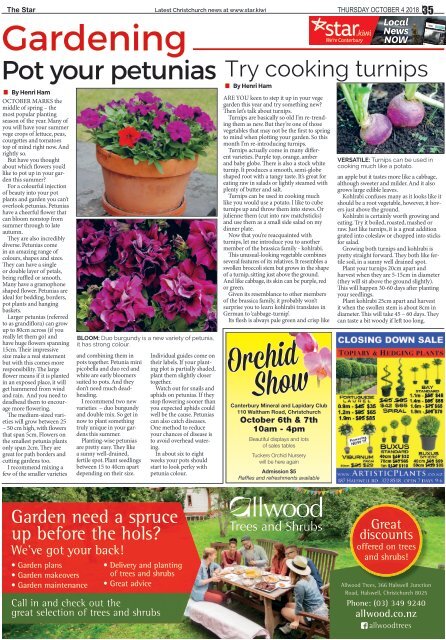The Star: October 04, 2018
You also want an ePaper? Increase the reach of your titles
YUMPU automatically turns print PDFs into web optimized ePapers that Google loves.
<strong>The</strong> <strong>Star</strong> Latest Christchurch news at www.star.kiwi<br />
Thursday <strong>October</strong> 4 <strong>2018</strong> 35<br />
Gardening<br />
Pot your petunias<br />
• By Henri Ham<br />
OCTOBER MARKS the<br />
middle of spring – the<br />
most popular planting<br />
season of the year. Many of<br />
you will have your summer<br />
vege crops of lettuce, peas,<br />
courgettes and tomatoes<br />
top of mind right now. And<br />
rightly so.<br />
But have you thought<br />
about which flowers you’d<br />
like to pot up in your garden<br />
this summer?<br />
For a colourful injection<br />
of beauty into your pot<br />
plants and garden you can’t<br />
overlook petunias. Petunias<br />
have a cheerful flower that<br />
can bloom nonstop from<br />
summer through to late<br />
autumn.<br />
<strong>The</strong>y are also incredibly<br />
diverse. Petunias come<br />
in an amazing range of<br />
colours, shapes and sizes.<br />
<strong>The</strong>y can have a single<br />
or double layer of petals,<br />
being ruffled or smooth.<br />
Many have a gramophone<br />
shaped flower. Petunias are<br />
ideal for bedding, borders,<br />
pot plants and hanging<br />
baskets.<br />
Larger petunias (referred<br />
to as grandiflora) can grow<br />
up to 80cm across (if you<br />
really let them go) and<br />
have huge flowers spanning<br />
15cm. <strong>The</strong>ir impressive<br />
size make a real statement<br />
but with this comes more<br />
responsibility. <strong>The</strong> large<br />
flower means if it is planted<br />
in an exposed place, it will<br />
get hammered from wind<br />
and rain. And you need to<br />
deadhead them to encourage<br />
more flowering.<br />
<strong>The</strong> medium-sized varieties<br />
will grow between 25<br />
– 50 cm high, with flowers<br />
that span 5cm. Flowers on<br />
the smallest petunia plants<br />
only span 2cm. <strong>The</strong>y are<br />
great for path borders and<br />
cutting gardens too.<br />
I recommend mixing a<br />
few of the smaller varieties<br />
BLOOM: Duo burgundy is a new variety of petunia,<br />
it has strong colour.<br />
and combining them in<br />
pots together. Petunia mini<br />
picobella and duo red and<br />
white are early bloomers<br />
suited to pots. And they<br />
don’t need much deadheading.<br />
I recommend two new<br />
varieties – duo burgundy<br />
and double mix. So get in<br />
now to plant something<br />
truly unique in your gardens<br />
this summer.<br />
Planting-wise petunias<br />
are pretty easy. <strong>The</strong>y like<br />
a sunny well-drained,<br />
fertile spot. Plant seedlings<br />
between 15 to 40cm apart<br />
depending on their size.<br />
Individual guides come on<br />
their labels. If your planting<br />
plot is partially shaded,<br />
plant them slightly closer<br />
together.<br />
Watch out for snails and<br />
aphids on petunias. If they<br />
stop flowering sooner than<br />
you expected aphids could<br />
well be the cause. Petunias<br />
can also catch diseases.<br />
One method to reduce<br />
your chances of disease is<br />
to avoid overhead watering.<br />
In about six to eight<br />
weeks your pots should<br />
start to look perky with<br />
petunia colour.<br />
• By Henri Ham<br />
ARE YOU keen to step it up in your vege<br />
garden this year and try something new?<br />
<strong>The</strong>n let’s talk about turnips.<br />
Turnips are basically so old I’m re-trending<br />
them as new. But they’re one of those<br />
vegetables that may not be the first to spring<br />
to mind when plotting your garden. So this<br />
month I’m re-introducing turnips.<br />
Turnips actually come in many different<br />
varieties. Purple top, orange, amber<br />
and baby globe. <strong>The</strong>re is also a stock white<br />
turnip. It produces a smooth, semi-globe<br />
shaped root with a tangy taste. It’s great for<br />
eating raw in salads or lightly steamed with<br />
plenty of butter and salt.<br />
Turnips can be used in cooking much<br />
like you would use a potato. I like to cube<br />
turnips up and throw them into stews. Or<br />
julienne them (cut into raw matchsticks)<br />
and use them as a small side salad on my<br />
dinner plate.<br />
Now that you’re reacquainted with<br />
turnips, let me introduce you to another<br />
member of the brassica family - kohlrabi.<br />
This unusual-looking vegetable combines<br />
several features of its relatives. It resembles a<br />
swollen broccoli stem but grows in the shape<br />
of a turnip, sitting just above the ground.<br />
And like cabbage, its skin can be purple, red<br />
or green.<br />
Given its resemblance to other members<br />
of the brassica family, it probably won’t<br />
surprise you to learn kohlrabi translates in<br />
German to ‘cabbage-turnip’.<br />
Its flesh is always pale green and crisp like<br />
Local<br />
News<br />
Now<br />
Try cooking turnips<br />
Orchid<br />
Show<br />
Canterbury Mineral and Lapidary Club<br />
110 Waltham Road, Christchurch<br />
<strong>October</strong> 6th & 7th<br />
10am - 4pm<br />
Beautiful displays and lots<br />
of sales tables<br />
Tuckers Orchid Nursery<br />
will be here again<br />
Admission $5<br />
Raffles and refreshments available<br />
Fire rages, homes at risk<br />
VERSATILE: Turnips can be used in<br />
cooking much like a potato.<br />
an apple but it tastes more like a cabbage,<br />
although sweeter and milder. And it also<br />
grows large edible leaves.<br />
Kohlrabi confuses many as it looks like it<br />
should be a root vegetable, however, it hovers<br />
just above the ground.<br />
Kohlrabi is certainly worth growing and<br />
eating. Try it boiled, roasted, mashed or<br />
raw. Just like turnips, it is a great addition<br />
grated into coleslaw or chopped into sticks<br />
for salad.<br />
Growing both turnips and kohlrabi is<br />
pretty straight forward. <strong>The</strong>y both like fertile<br />
soil, in a sunny well drained spot.<br />
Plant your turnips 20cm apart and<br />
harvest when they are 5-15cm in diameter<br />
(they will sit above the ground slightly).<br />
This will happen 30-60 days after planting<br />
your seedlings.<br />
Plant kohlrabi 25cm apart and harvest<br />
it when the swollen stem is about 8cm in<br />
diameter. This will take 45 – 60 days. <strong>The</strong>y<br />
can taste a bit woody if left too long.<br />
Garden need a spruce<br />
up before the hols?<br />
We’ve got your back!<br />
• Garden plans<br />
• Garden makeovers<br />
• Garden maintenance<br />
• Delivery and planting<br />
of trees and shrubs<br />
• Great advice<br />
Call in and check out the<br />
great selection of trees and shrubs<br />
Great<br />
discounts<br />
offered on trees<br />
and shrubs!<br />
Allwood Trees, 366 Halswell Junction<br />
Road, Halswell, Christchurch 8025<br />
Phone: (03) 349 9240<br />
allwood.co.nz<br />
allwoodtrees


















